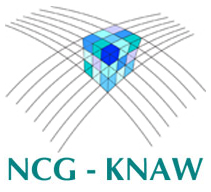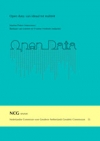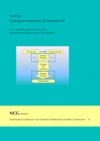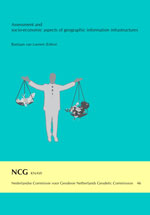



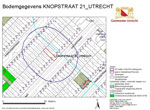
Proceedings of the Workshop on Assessment and Socio-economic Aspects of Spatial Data Infrastructures
Bastiaan van Loenen (Editor)
Nederlandse Commissie voor Geodesie 46, Delft, 2008. 99 pagina's.
ISBN: 978 90 6132 308 2.
Preface
Socio-economic aspects of geographic information (infrastructures) (GII) are increasingly considered in GII development and especially in GII research. Where once the technological dimension of GII was the dimension assessed to be most relevant, it is now commonly understood that also the non-technical aspects should be addressed and understood in order to promote GII development. There may even a trend be recognised towards a nontechnical focus of GII strategies.
The socio-economic side of GII is also atracting the attention of the research community. It is evident that we are only at the beginning of the development of this loose network of those researching socio-economic GII issues (see De Man's paper). For one socio-economic aspect, the GII assessment aspect, a true loose network linking those with assessment expertise now not only shares experiences, but is also cooperatively working on the assessment issue. For other socio-economic issues such a network is still in development. One way of extending the socio-economic network is to disseminate the pool of ideas and research outcomes to speak of a true community of practice as De Man has put it.
The proceedings of the workshop on Assessment and Socio-economic Aspects of Spatial Data Infrastructures contributes to this objective. This booklet presents the outcomes of this workshop. The workshop was initiated by the OTB Research Institute of Delft University of Technology to commemorate two years of research by one of its staff members, Garfield Giff. A selected group of academics and professionals were invited to join the workshop and to share experiences in the socio-economic frameworks within which geographic information infrastructures are emerging whether within an individual nation or across multinational regions. The contributions reflect the variety of socio-economic aspects of GII. More specifically, the presented work covers GII assessment theory, applied GII assessment, GII and eGovt, sociology and privacy.
The first paper, 'Theoretical considerations for multi-view SDI assessment' by Luckasz Grus, Joep Crompvoets and Arnold Bregt, stress the importance to assess GII outcomes in order to justify the resources spent on those infrastructures. Many researchers throughout the world have been struggling with the issue of assessing GIIs. The task is difficult due to their complex, dynamic and constantly evolving nature. They argue that GIIs can be treated as a Complex Adaptive System, and therefore assessment should include strategies for evaluating those kinds of systems. They present the multi-view framework for assessing GII initiatives around the world, and argue that the strength of this assessment design lies in its flexibility, its multidisciplinary view on GII and a reduced bias in the assessment results.
Garfield Giff addresses one specific component of the multi-view framework in his paper 'Using performance indicators to assess SDIs/GISs'. He discusses the need for accountability assessment of GIIs to determine their relevance and to justify financial support. Within this discussion, methodologies to facilitate this type of assessment were analysed and the decision taken that the application of Performance Indicators (PIs) to GII assessment would enhance the process. However, due to the complicated nature of a GII's performance the author concluded that there should be in place a guide to aid in the design of PIs for measure performance when conducting an accountability assessment. This guide in the form of a framework was presented and analysed within three case studies on the design of PIs for GIIs.
The theoretical papers are followed by two papers that include an actual assessment of a GII. First, Wilbert Kurvers applies in 'SDI assessment from an organizational perspective' an organizational assessment methodology to the GII of the Dutch Province of Limburg and German local governments. He developed an assessment model based on GII theory, the Technology Acceptance Model and an Organisational Development Model. He distinguishes in his model the ability of organisations to implement GII and their willingness to actual do so. Two third of the local governments in his case studies appear to be unable and unwilling to implement GII. His research outcomes suggest that the real challenges for GII implementation are at the local level.
Arif ğdaş Aydinoğlu, Halil İbrahim İnan, and Tahsin Yomralioğlu also assess the subnational level in their paper 'Examining SDI development of Turkey as a socio-technical approach'. They use a rainbow metaphor of GII addressing governance, literacy, provision, content, software, devices and carriage to assess the GII of the Turkish Province of Trabzon. Although there are a lot of good intentions and initiatives, they conclude that the Turkish GII requires a leader for further GII development especially to make the GII part of the Turkish e-government and information infrastructure initiatives.
Walter de Vries researches in his paper 'SDI as a distant ship on the horizon of EGov' the links between research in GII and e-government. He sought empirical evidence and references for this link by comparing the important words and 'jargon' of the GII community with those within the most relevant publications in the EGov scientific community. His investigation shows considerable overlap between the two communities' wording. However, De Vries raises the question whether the presumed communalities between GII and EGov research really exist. GII and EGov implementation are addressed from different communities, different authorities and from different interests resulting very little overlap in publications and very few links between implementation strategies. This raises another question: would it be possible to merge GII and EGov research or are the two communities truly unique?
Erik de Man focuses in 'Crisis in the SDI field? Or a vibrant market of ideas and initiatives between rhetoric and praxis' on the sociological aspect of GII communities. He warns for GII rhetorics leading to a misperception of reality; a collective fantasy world of GII. He wonders whether the GII field is in crisis, provided a suggested discrepancy between optimistic rhetoric and unruly reality of GII implementation. He concludes that the GIIs emerge as vibrant markets of ideas and initiatives which are far from a crisis.
The last paper by Bastiaan van Loenen ('Implications of privacy for INSPIRE and vice versa') addresses privacy and geographic information in relation to INSPIRE. He notices that geographic information comes in many shapes and sizes and therefore privacy law may or may not apply. Generally, the higher the level of detail the more likely it is privacy law applies. The impact on INSPIRE is for a major extent depending on the outcomes of the decision on the data set specifics such as level of detail. Since these data specifications are unavailable yet, the extent to which the privacy law applies and limits the use of INSPIRE data remains unknown.
The workshop was organised by and held at Delft University of Technology on April 11, 2008. We are grateful to the Netherlands Geodetic Commission (NCG) for their willingness to publish this work that allows also others to use the experiences and research presented in the workshop to their advantage.
The editor, Bastiaan van Loenen Delft University of Technology
Contents
Preface vii
Bastiaan van Loenen, Editor
Theoretical considerations for multi-view SDI assessment 1
Lukasz Grus, Joep Crompvoets, Arnold Bregt
Using Performance Indicators to assess SDIs / GISs 13
Garfield Giff
SDI assessment from an organizational perspective 23
Wilbert Kurvers
Examining SDI development of Turkey as a socio-technical approach 43
Arif Çağdaş Aydinoğlu, Halil İbrahim İnan and Tahsin Yomralioğlu
SDI as a distant ship on the horizon of EGov 53
Walter de Vries
Crisis in the SDI field? Or a vibrant market of ideas and initiatives between rhetoric and praxis 65
Erik de Man
Implications of privacy for INSPIRE and vice versa 77
Bastiaan van Loenen
